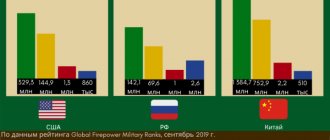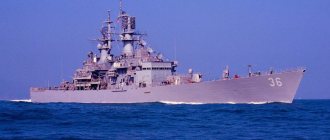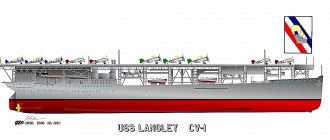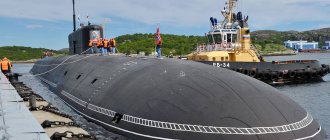A universal truth that has remained unshakable since ancient times: a country with a coastline has a navy. Large or small, strong or weak, modern or outdated, navies have the same core mission - to project the power of a nation into neighboring waters and beyond. They defend their home country, keep shipping trade routes open, display the flag, and deter the enemy. We can safely say that a country’s geopolitical influence largely depends on the strength of its fleet.
Shariy.net offers its Top 5 most powerful fleets in the world, based on the number of ships, total tonnage, firepower according to Global Firepower and Jane's Fighting Ships, and other factors.
Great Britain. Tradition is still strong
In Britain they like to say that “it takes 30 years to build a fleet, but it will take at least 300 to acquire traditions.” Since the mid-18th century, the Royal Navy was the most powerful in the world, playing a key role in the creation of the British Empire, but after the Second World War it was eclipsed by the US and Soviet navies. Due to funding cuts, it continues to gradually decrease, but even now it remains one of the most advanced, with the most powerful weapons in Europe.
The Royal Navy has approximately 33,000 personnel. It includes one aircraft carrier, and a second ship of this class is planned to be completed in the coming years. Although they are significantly smaller than their American counterparts, they are distinguished by their speed and maneuverability.
The British Navy operates 6 anti-aircraft destroyers, which can patrol large areas, and 13 frigates, designed to combat submarines. It consists of a 7,700-strong Marine Commando brigade. 5 logistics landing ships are used to land military personnel.
The UK has 10 nuclear submarines, with another 4 submarines currently under construction. Each of them carries a stockpile of ballistic missiles sufficient to wipe out entire countries. At least one submarine is always on combat patrol and is ready to use its weapons at any time.
The British Navy uses a variety of helicopters for search and rescue operations, anti-submarine warfare, and support functions. Close support aircraft were retired more than 10 years ago, and replacement fighters have yet to enter service.
Indonesia
the largest merchant fleet in the world today and they have been at the forefront for a long time. The number of units currently includes 9,879 ships, the largest figure to date. After all, over 10 thousand kilometers of river passenger routes, about 50 rivers and three hundred ports are laid through the state. Every year they only increase their influence, because their geographical location contributes to this.
Japan. To new heights, despite limitations
The Japanese Navy is forced to exist under severe restrictions imposed on it after its defeat in World War II. The country is prohibited from using long-range cruise missiles and building nuclear submarines. However, even in such a situation, the Japanese Maritime Self-Defense Forces stand out qualitatively from most of the world's fleets, distinguished by a well-thought-out, balanced system of operations in coastal waters and the open ocean.
Japan's fleet consists of 50,800 people, more than 150 ships and almost 346 aircraft. He is constantly on full alert and extremely combat-ready. Although the Japanese Navy is inferior to the Chinese Navy in terms of the number and tonnage of ships, Japanese warships are more advanced and equipped with the most modern weapons.
The Japanese fleet does not have aircraft carriers, but there are 4 helicopter carriers that are capable of conducting landing operations and fighting surface and submarines. It was recently announced that these warships will be converted into aircraft carriers in response to China's rapid naval buildup. The Japanese Navy has 30 large destroyers, almost the same size as cruisers, 10 frigates and 6 small escort destroyers (corvettes).
Japan has 3 large landing ships that can land a small marine force of just over 3,000 men. Its official role is to counterattack captured islands and recapture them (the Kuril archipelago is often mentioned when this doctrine is mentioned).
The Japanese fleet has about 20 diesel submarines, many of which are superior to nuclear-powered submarines in terms of their combined characteristics. Japan's naval aviation includes about 70 full-fledged and a dozen small patrol aircraft.
Panama's merchant fleet is the largest in the world
For many years, the state with the largest merchant fleet has been Panama. In 2016, 8,153 merchant ships plied the seas under the flag of this country. Panama also leads in the tonnage of cargo transported by water. This is due to several circumstances:
- the state owns many seaports;
- The Panama Canal passes through the country, through which transport ships ply between the South American and North American continents;
- Registration of a vessel in Panama does not require mandatory tax payments;
- The country has very low duties.
Panama Merchant Navy
Owners of merchant ships from many countries around the world prefer to sail under the flag of Panama, since their personal data is not disclosed in this country. The state register enjoys the authority of financial institutions, thanks to which goods transported on ships flying the Panamanian flag are reliably protected. In addition, the country does not have strict laws regulating the work of seafarers, which allows shipowners to save on wages for crew members.
China. The dragon quickly spreads its wings
Until the late 1980s, the Chinese fleet consisted of ships capable of operating only off the coast. However, China subsequently began to expand its fleet and is currently building new ships and submarines at a record pace, becoming the world's second largest by tonnage. The goal of such super-efforts is the policy of the PRC, which does not recognize the independence of Taiwan and intends to return it, which is impossible without a powerful fleet. However, the Chinese have still not been able to offer a single original idea in shipbuilding. All samples of their naval weapons are copies of Russian and Western analogues, inferior to the originals.
The Chinese Navy has about 255,000 personnel. It has 2 aircraft carriers, the first of which, Liaoning, was purchased from Ukraine for scrap metal for $20 million and subsequently completed. It also includes about 30 destroyers, 50 frigates and 40 corvettes. Many of the older warships are inferior to their foreign counterparts, but China is modernizing and re-equipping them. 6 missile cruisers were also commissioned.
The Chinese amphibious force has 4 amphibious docks, 32 tank landing ships and 31 medium landing ships, with 10,000 marines that can land on enemy shores.
The Chinese Navy has 68 submarines, including 6 nuclear-powered intercontinental ballistic missile submarines, which have never conducted operational patrols to date, possibly due to design flaws.
The Chinese Navy operates more than 700 aircraft providing air defense, including more than 140 multi-role fighters. Several naval attack aircraft and more than 30 medium-range bombers are used, designed to destroy US aircraft carrier groups.
USA
America also manages to become one of the leaders, as the largest merchant fleet in the world , or rather one of the top five. They have about 3,673 ships that cooperate with neighboring states. The most important maritime merchant fleet in the state of Florida, from where they transport oil and products containing this resource. About 16 million tons leave here every year. If you look at it, this country could actually raise it higher, but they are used to registering their companies where taxes and duties are low.
Russia. Revival and augmentation of the former formidable power
The Russian Navy is the successor to the USSR fleet, which once shared first place with the US Navy. Original finds, unusual approaches to warfare, the best school for creating anti-ship missiles, unique titanium submarines. The USSR had all this. But since the early 1990s, due to funding problems, the Russian fleet has shrunk significantly in size. Many ships fell into disrepair and were scrapped. Only in the last two decades has it begun to be replenished with new ships with modern weapons, mainly submarines. The Russian Navy is experiencing problems with the construction of new ships of the first rank (cruisers, destroyers, aircraft carriers), but the efforts made and innovative technologies allow it to maintain second place in the rating.
The personnel of the Russian Navy number about 140,000 people. The Russian fleet has a single aircraft carrier at its disposal, which is inferior in performance to the newest American aircraft carriers and can accommodate fewer aircraft. At the moment, the ship is undergoing repairs and modernization due to problems with the propulsion system.
The flagship of the Russian fleet is a heavy nuclear-powered missile cruiser. Also in the fleet are 3 smaller guided missile cruisers, which have significant anti-ship, anti-aircraft and anti-submarine capabilities. The Russian Navy has 15 destroyers, 9 frigates and 24 corvettes.
The Russian marine corps is quite small and numbers only about 12,000 people. To deliver it to the shore, 20 landing ships of different classes are used. These combat vessels are maneuverable and capable of ultra-long voyages, but are much smaller in size than their American counterparts.
The Russian Navy operates a number of nuclear submarines, which are considered its pride. These are the largest submarines ever built, designed to attack strike groups of American aircraft carriers and coastal targets. There are a significant number of diesel submarines in service, used for the defense of naval bases. Russia is investing heavily in creating new submarines that can carry intercontinental missiles with nuclear warheads.
Naval aviation has about 360 aircraft, including anti-submarine and tactical bombers.
On paper, the Russian fleet is inferior to the Chinese in terms of the number and tonnage of ships. However, it is armed with a number of proven ballistic missile submarines, and also introduces the latest technologies that are significantly superior to their global counterparts.
Liberia
In the ranking you can also find merchant fleets for countries that are small in size. However, they have enough resources to compete with world leaders in this area. The largest port here is Monrovia, located in the bay of the Atlantic Ocean. Across Africa, this is the largest merchant fleet 2022, and in terms of tonnage it can rise even higher. Today, about 3,496 vessels operate here for the benefit of the state's economy.
Hong Kong Merchant Navy
The administrative region of China is Hong Kong, which has a large merchant fleet. In 2016, 2,515 merchant ships sailed under its flag. In 6 years, the Hong Kong merchant fleet has increased by less than 2 times. This decline in the development of water transport is due to strict rules for registering ships. Owners are also deterred by high duties and taxes. For this reason, about a third of merchant ships owned by individuals or companies in Hong Kong are registered in other countries.
Hong Kong Merchant Navy
Marshall Islands Merchant Navy
In 2016, there were 2,942 merchant ships flying the flag of the Marshall Islands. Since 2010, the number of water transport in the country has more than doubled. This is because the Marshall Islands offer a "flag advantage". Registration of vessels in the state takes place in the shortest possible time, and owners of water transport can maintain confidentiality. Even with serious violations of the law, it is almost impossible to determine which company or individual owns a merchant ship. That is why most of the merchant ships sailing under the flag of the Marshall Islands are owned by foreign owners.
Marshall Islands Merchant Navy











